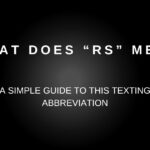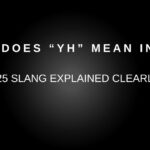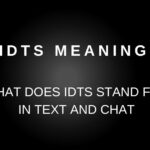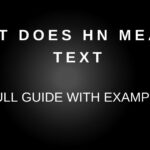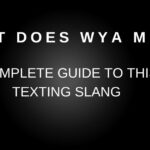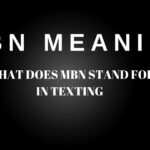Have you ever received a text that just says ‘WYA’ and wondered what it means? You’re not alone. Whether it’s Snapchat, Instagram, or WhatsApp, WYA is a quick way to ask where someone is. This guide will explain WYA in simple words, show playful examples, and teach you how to reply like a pro.
What Does WYA Mean?
WYA stands for ‘Where You At.’ It’s a short, casual way to ask someone’s location in texting or social media. Teens and young adults use it because it’s fast and easy. On Snapchat, WYA often means ‘Hey, want to hang out now?’ On Instagram, it might be a fun check after someone posts a story. On WhatsApp, it’s perfect for group meetups.
According to Merriam-Webster’s dictionary on texting abbreviations, acronyms like WYA are part of modern informal English used in quick chats.
Quick Facts:
- Full Form: Where You At
- Type: Texting abbreviation / slang
- Common On: Snapchat, Instagram, WhatsApp, SMS conversations
- Tone: Casual, friendly, sometimes curious
Where Did WYA Come From?
WYA comes from African American Vernacular English (AAVE), where people often say ‘Where you at?’ casually. Over time, texting culture shortened it to WYA. Social media and texting apps helped it spread worldwide.
As text messaging and online chatting grew popular in the early 2000s, people started shortening phrases to save time. WYA became one of those go-to shortcuts in digital spaces.
As someone who loves following how internet slang changes, I’ve seen WYA spread from simple texts to social media stories everywhere.
By 2025, it’s everywhere—from group chats to direct messages on apps like Instagram and WhatsApp.
What Does WYA Mean in Text or Chat?
When someone texts you WYA, they’re asking where you are right now.
It’s usually because they want to meet up, check in on you, or see what you’re doing. The context can change the tone, but the basic meaning of WYA stays the same.
Here’s how it plays out in real conversations:
Example 1:
- Friend: “WYA?“
- You: “At home, why?”
- Friend: “Wanna grab food?”
Example 2:
- Sibling: “WYA? Mom’s asking.”
- You: “At Jamie’s place, be back soon.”
Example 3:
- Friend: “Concert starts in 20 mins, WYA?”
- You: “On my way!”
Related: MBN Meaning: What Does MBN Stand For in Texting?
What Does WYA Mean on Snapchat, Instagram, and WhatsApp?
The core meaning stays consistent across platforms, but each app adds its own flavor.
On Snapchat, people often use WYA when planning spontaneous hangouts. It feels light and casual—like “Hey, what’s up? Where are you?”
On Instagram DMs, WYA might come up if someone sees your story. Maybe you posted a pic at a coffee shop, and a friend asks “WYA?” to see if they can join you.
On WhatsApp, it’s common in group chats when coordinating meetups or checking who’s nearby.
Platform Breakdown:
| Platform | Common Use | Example |
| Snapchat | Spontaneous hangouts | “WYA? Let’s link up!” |
| Responding to stories | “Saw your story—WYA?“ | |
| Group planning | “WYA? Everyone’s waiting.” |
Is WYA Positive, Negative, or Neutral?
WYA is mostly neutral, but the emotional tone depends on who’s asking and why.
If a close friend asks WYA, it’s probably just curiosity or excitement about hanging out. If a parent texts it late at night, it might carry concern. If someone’s been waiting, it can sound impatient.
Let’s break down the different vibes:
Friendly Tone
When friends or siblings ask WYA, it’s relaxed and casual.
Example: “WYA? I’m bored, let’s do something.”
Concerned Tone
Sometimes WYA shows genuine care.
Example: “It’s late, WYA? Just making sure you’re safe.”
Impatient Tone
If someone’s been waiting or needs you urgently, WYA can sound pushy.
Example: “Dude, WYA? We’ve been here for 20 minutes.”
Flirty Tone
Yes, WYA can even sound romantic depending on context.
Example: “WYA? Been thinking about you 😏”
When paired with certain emojis or playful language, WYA takes on a different vibe.
How to Reply to WYA
Answering WYA is simple—just share your location or plans.
Keep your reply short and clear, especially if someone’s waiting. You can also add a quick follow-up question to keep the conversation going.
| Type | Example Reply | Platform Angle |
|---|---|---|
| Direct | “At the mall, grab something?” | Snapchat |
| Context | “Still at work, free in 30.” | |
| Playful | “Wouldn’t you like to know? 😂” | |
| Polite Decline | “Home tonight, maybe tomorrow?” | All platforms |
| Flirty | “On my way 😏” | Instagram/Snapchat |
Tip: Add follow-up question to make conversation natural.
Example: “At the gym. You coming too?”
What Does WYA Mean from a Girl or Guy?
The meaning of WYA doesn’t change based on gender, but the subtext might shift.
From a girl: “She’s curious or wants to hang out—maybe flirty. Example: ‘WYA? Movie night?’”
From a guy: “Usually direct—checking your location or making plans. Example: ‘WYA? Meet at the park.’”
The context and your relationship tell you more than the words themselves.
How to Use WYA in Conversations
Want to start using WYA yourself? Just drop it in casual chats when you want to know someone’s location.
Here are natural ways to use WYA:
Making plans: “WYA? Coffee in 10?”
Checking in: “Haven’t seen you today, WYA?”
Casual curiosity: “Saw your snap—WYA?”
Fun/playful: “WYA? Or still in bed? 😂”
Usage Tips:
- Use WYA with people you’re comfortable with—friends, siblings, close colleagues.
- Avoid WYA in business messages, academic writing, or formal email.
- Add emojis if you want to soften the tone (e.g., “WYA? 😊”).
When NOT to Use WYA
WYA works great for casual conversations, but skip it in professional or formal settings.
It can sound too informal or even nosy in the wrong context.
Avoid WYA Here:
| Situation | Why Avoid WYA | Better Alternative |
|---|---|---|
| Work | Too casual | “Where are you now?” |
| Unprofessional | “Could you share your location?” | |
| Clients | Might sound pushy | “Are you nearby?” |
| First-time text | Too informal | “Where should we meet?” |
Youth culture loves WYA, but older generations or formal settings need a more polite approach.
Professional Alternatives to WYA
If you need to ask someone’s location in a work setting, here are polite ways to phrase it:
- “Where are you right now?”
- “Are you nearby?”
- “What’s your current location?”
- “Are you available to meet?”
- “Just checking—where should I find you?”
Workplace texting etiquette matters, especially with colleagues you’re not super close to. Keep it professional and avoid awkwardness.
WYA vs. Other Texting Acronyms
WYA is just one of many texting abbreviations people use daily.
Lists like popular text slang show how terms such as WYD, BRB, and LMK became everyday digital language.
Here’s how it compares to similar slang:
| Slang | Meaning | Example |
|---|---|---|
| WYA | Where You At | “WYA? At the park!” |
| WYD | What You Doing | “WYD tonight?” |
| LMK | Let Me Know | “LMK if you’re free” |
| BRB | Be Right Back | “BRB, grabbing snacks” |
| IDC | I Don’t Care | “IDC about the movie” |
| SMH | Shaking My Head | “SMH, can’t believe it” |
Each acronym serves a different purpose, making digital communication faster and easier.
Tips for Understanding Digital Tone
Tone in text messages can be tricky since you don’t hear someone’s voice.
Here’s how to read WYA (and other texting slang) correctly:
Look at Punctuation
- “WYA?” = Curious, normal
- “WYA” (no question mark) = Direct, maybe urgent
- “WYA??” = Impatient or worried
Check the Emojis
- “WYA? 😊” = Friendly
- “WYA? 😏” = Playful or flirty
- “WYA? 😒” = Annoyed
WYA Tone and Examples
Friendly: “WYA? Bored here 😄”
Concerned: “It’s late, WYA? Just checking 🧐”
Impatient: “Dude, WYA?? We’re waiting!”
Flirty: “WYA? Been thinking about you 😏”
Consider Message Length
Short messages feel more casual or urgent. Longer ones with extra words (like “Hey, just wondering WYA?“) sound softer and more polite.
These softeners help you manage digital tone and avoid misunderstandings.
Cross-Cultural and Cross-Generational Use
Teens and young adults use it constantly, but older generations might not recognize it right away. If you’re texting someone outside your age group, consider spelling it out: “Where are you?”
Cross-cultural communication also matters. People who didn’t grow up with internet slang might find WYA confusing. Always mirror tone and adjust your communication style to match your audience.
Note: Meanings and tone can change a little across different cultures or age groups, so always read the context before you reply.
FAQs About WYA Meaning
What does WYA mean in text or chat?
WYA means “Where You At” or “Where Are You.” It’s a casual way to ask someone’s current location in text messaging or online conversations.
Is WYA rude or impolite?
Not usually. WYA is informal but not rude. The tone depends on context—if someone’s annoyed, it might sound pushy. Most of the time, it’s just a friendly check-in.
How do you reply to WYA?
Just tell them where you are. Keep it short and clear.
Example: “At the mall” or “Still at work, why?”
What does WYA mean from a girl?
It means she’s asking where you are. The subtext could be friendly, curious, or flirty depending on your relationship.
What does WYA mean from a guy?
Same thing. He wants to know your location, whether to make plans or check in.
Can WYA have other meanings?
Rarely. WYA almost always means “Where You At.” Some people joke about other meanings, but stick with the main definition of WYA to stay clear.
Is WYA only used on Snapchat and Instagram?
No. You’ll see WYA on WhatsApp, SMS, and other chat apps too. It’s popular wherever people text casually.
Should I use WYA in professional messages?
Avoid it. WYA is too casual for business communication or workplace texting. Use professional alternatives like “Where are you right now?” instead.
Conclusion
“WYA is a fun, simple way to ask someone’s location online. Use it in casual chats on Snapchat, Instagram, or WhatsApp. Match the tone, add playful emojis, and now you can reply confidently in any situation. Try it today, and make your conversations smoother and more fun!
Want to learn more internet slang? Check out what BRB, WYD, LMK, and SMH mean next—they’re just as useful in everyday chat slang.

Hello! It’s Bill, The editorial team of profilesgrace.com, a group of writers who love explaining real-life things in simple words. Our team researches language, slang, measurements, and everyday topics so you always get clear, true, and helpful answers. We use real examples and trusted sources to make learning easy and fun for everyone. Experience meets honesty in every post we write.

